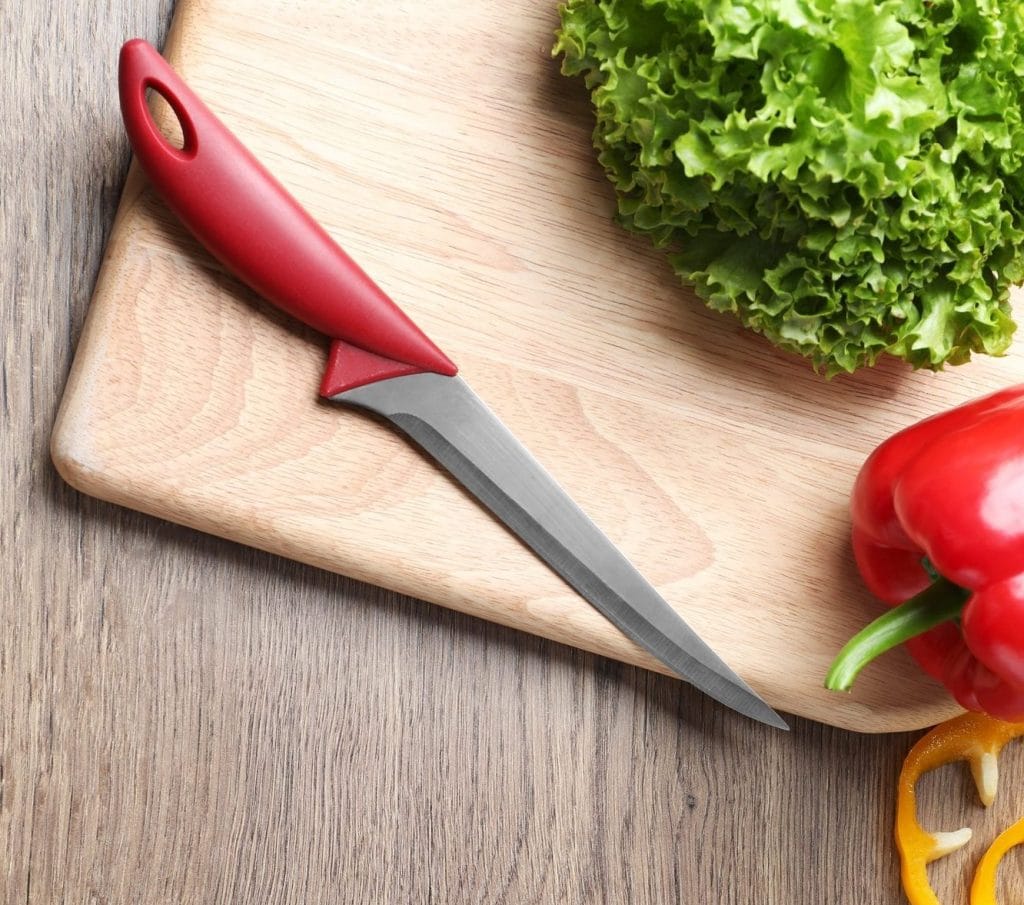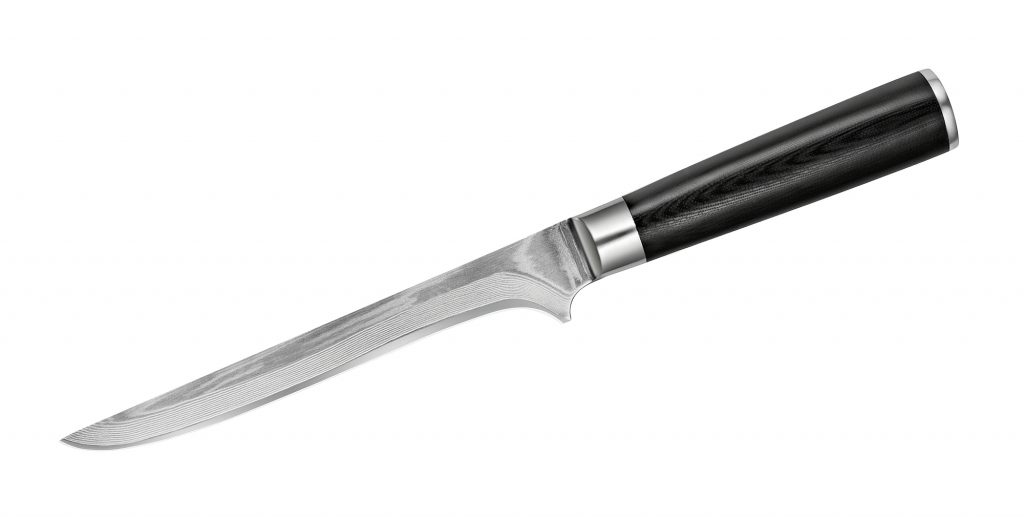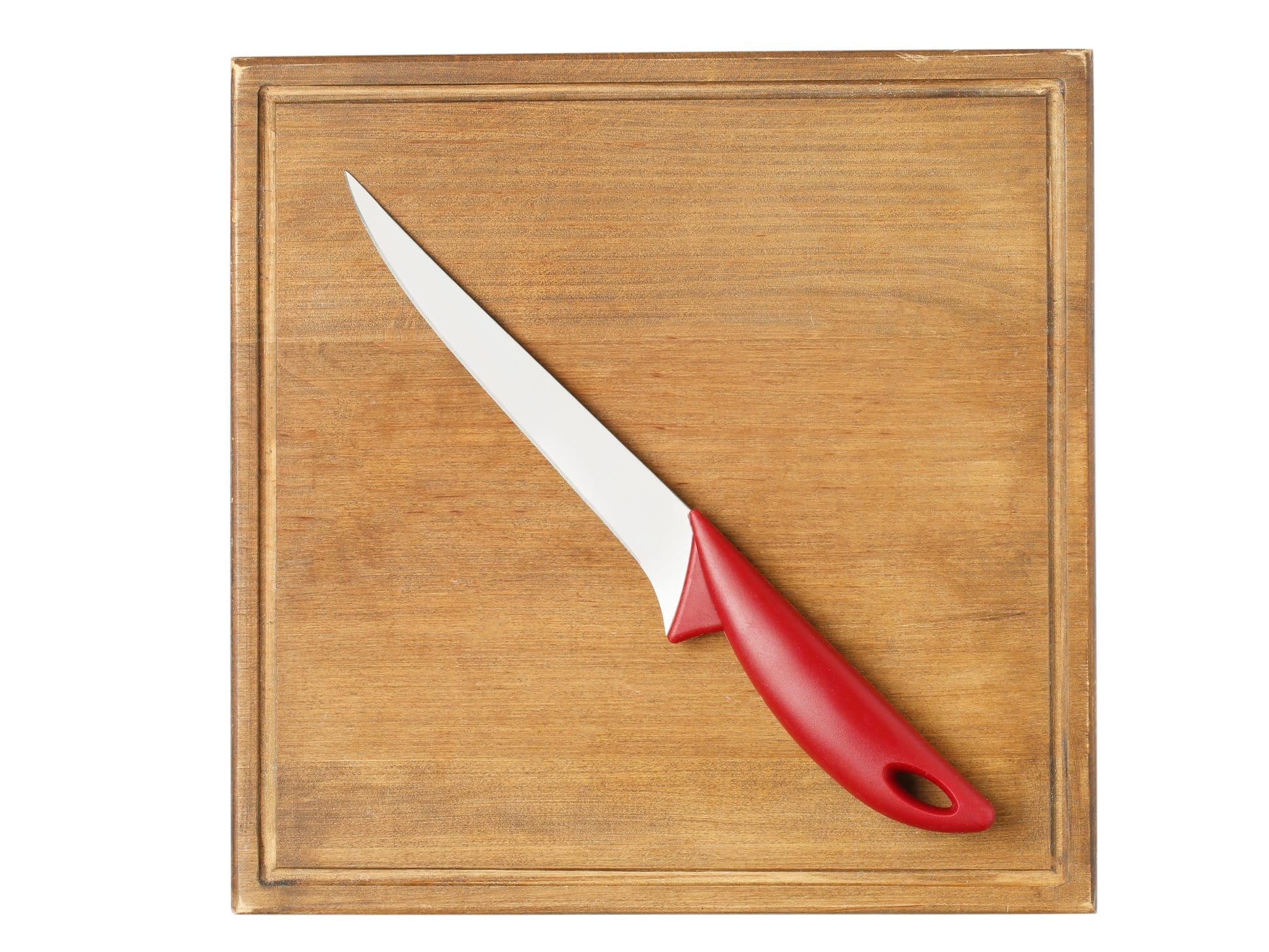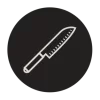Creating the ideal kitchen means getting the right kitchen tools. Knives are an important part of any kitchen line-up, especially for meat-eaters. A boning knife is a valuable tool in every carnivore’s kitchen. Boning knives help you separate bones from meat, poultry, and fish.
The best boning knife is the one that’s right for you. This depends on how you will use the knife and which kinds of meat and fish you need to prepare. This guide will cover everything you need to know so that you can choose the right boning knife. Once you understand the characteristics of boning knives, you can explore the 5 Best Boning Knives on the market.
How to Choose the Best Boning Knife For You
There is a lot of parameters you need to consider while you pick your perfect Boning Knife, including: what you need it for, price range, length & weight, blade, and more. Remember, how to choose a Boning Knife is an individual choice according to your needs.
What is a boning knife?
A boning knife is exactly what it sounds like: a knife specifically designed to separate bones from meat. This kitchen knife has a sharp point and a narrow blade. The sharp blade helps you make clean cuts through joints, cartilage, and ligaments.
What does a boning knife look like?
Generally, boning knives are 5 to 8 inches long and have stiff narrow blades. Boning knives may have a straight or arched blade. Many people confuse fillet knives and boning knives.
Fillet knives are actually a type of boning knife. Fillet knives are flexible which allows you to carefully remove scales and bones from fish without damaging the flesh. Boning knives are thicker and stiffer than fillet knives and are used for fish and other meats. The main difference is that boning knives are stronger and more versatile than fillet knives.
What is a boning knife used for?
pork, and fish. Stiff boning knives are useful in making very precise cuts through tough parts of meat like sinew, muscle, fat, and ligaments. Here are some examples of typical scenarios where a boning knife is useful:
- Remove bones and skin from meat
- Prepare fruit with tough rinds or cores
- Remove bones and skin from fish fillets
- Cut frozen dough.
Here’s what NOT to use a boning knife for:
- Cutting through solid bones
- General chopping

The best knife for you depends on your personal preferences and the ways you plan to use it. Knowing this, keep reading to learn about the different properties of boning knives so that you can choose the best boning knife for your kitchen.
Price – How Much Does A Boning Knife Cost?
There is a huge price range when it comes to buying a boning knife. The price depends on your preferences and you can pay anywhere from $20 – $200 for a boning knife. Boning knife prices are based on their overall quality, including its dimensions, blade, handle, and balance.
Are boning knives worth it?
Boning knives help you cut around bones and flesh safely. Everyone knows that most kitchen accidents happen with dull knives. Boning knives are sharp enough to easily cut through tough ligaments, muscles, and sinew so that you don’t put your safety at risk while preparing meat.
A high-quality boning knife is not essential in every kitchen, especially not for vegetarians. However, if you are someone who prepares meat and fish often, adding a solid boning knife to your kitchen is a worthy investment. Good tools make the cooking process more enjoyable and you’ll notice cleaner, straighter cuts of meat which improve your final presentation.
Dimensions – The Length & Weight of a Boning Knife
There are two important dimensions to pay attention to when choosing a boning knife: total length and weight.
The length of a boning knife
Boning knives are generally measured in inches and centimeters. A typical boning knife length is between 5 – 8 inches (12 – 20 cm). Shorter blades will allow you to have more control over your cuts and longer blades will let you make deeper longer cuts.
What Is the best length for a boning knife?
The best length for a boning knife depends on what you plan to use it for. For cutting large pieces of meat from beef, lamb, or pork, a longer blade will be more helpful. For cutting around smaller more intricate bones in fish and poultry, a shorter blade will help you get the job done.
The weight of a boning knife
Weight is added to boning knives by materials used in the blade and the handle. Overall weight ranges from 5 – 10 ounces (140 – 285 grams).
What is a good weight for a boning knife?
You want a boning knife that you can comfortably use for the amount of time it takes to prepare your meat or fish. If your wrist gets sore while chopping vegetables, look for a boning knife on the lighter side so you can use it comfortably. This is also a matter of personal preference; some cooks prefer the feel of heavy knives and some like a more delicate grip.
The Boning Knife’s Blade

The blade is the most important part of the knife. When looking for a boning knife, pay attention to the characteristics of the blade and consider what you are going to use the knife for. These are the parts of the knife you should pay attention to:
- Point: The very top of the knife where the spine and edge come together; used for piercing.
- Tip: The top part of the knife that includes the point; used for precise cutting.
- Edge: The sharp side of the blade extending from the heel to the point.
- Spine: The top of the knife opposite the edge, extending from heel to the point.
- Heel: The part of the knife closest to the handle.
- Tang: The part of the blade that extends into the handle. This is where the handle attaches to the blade.
Whether you enjoy cooking at home or are a professional chef, you have a lot of options when it comes to picking a knife blade. We will cover everything you need to know to choose the best blade for your kitchen, including blade material, flexibility, thickness, edge, and tang.
What is the difference between forged and stamped blades for a boning knife?
If you’ve shopped for knives before, you’ve probably wondered, “Which is better, a forged or stamped boning knife?”. The main difference between forged and stamped blades is in how they are produced.
Forged blades are heat-treated and pounded into the right shape. The pounding process is believed to make forged knives harder and stronger which allows the blade to keep its edge longer. Stamped blades are cut from a large sheet of steel then heat-treated and honed.
As a result, forged boning knives will be heavier and thicker than stamped boning knives. A heavy forged blade will be a great tool for mincing while the lighter stamped blade will come in handy when slicing.
Blade material – What material should the boning knife blade be made of?
The most common blade material is stainless steel but that doesn’t mean it’s the best choice for you. There are a variety of materials that can be used to make knife blades so we will introduce some of the top materials and their properties.
- Carbon steel: This material is a basic mix of iron and carbon. It is harder than stainless steel, keeps a sharp edge longer, and is much easier to sharpen than stainless steel. Carbon steel is a popular choice for chefs who do a lot of cooking and want to avoid constant sharpening. A carbon steel boning knife will be on the more expensive side but it is worth it if you plan to do a lot of meat preparation.
- Stainless steel: This material is just like carbon steel but with chromium added. Chromium is what makes the steel resistant to corrosion and rust. This creates a softer steel. Although you’ll have to sharpen a stainless-steel blade more often, it is a more affordable blade and a popular choice for your average kitchen.
- Laminated steel: This material is made of multiple layers of different types of steel, giving it an extra strong core, which makes the blade sturdier and less likely to chip. Like carbon steel, laminated steel is strong and easy to sharpen.
- Ceramic: This material is sharp but brittle. Ceramic knives are very lightweight and easy to handle, but you should only use them for chopping fruits and vegetables.
- Damascus steel: This is a traditional material that has been used for both knives and swords, so you can bet it is going to be sharp! A Damascus steel knife is made of hard and soft steel, so it is powerful and delicate enough to make precise cuts. This is the kind of knife a professional chef would be proud to use in their kitchen, so it is going to be more expensive than carbon or stainless steel.
- Titanium: This material is resistant to water and general wear and tear. It has a sleek aesthetic to it but does not hold an edge very well. You’ll have to frequently sharpen a titanium blade. For a boning knife, you want a blade that stays sharp enough to cut through ligaments and joints so a titanium blade may not be your best option.
Blade flexibility – Should a boning knife have a flexible blade?
You can find flexible or stiff boning knife blades. The right choice depends on the types of meet you will prepare. A stiff blade is needed for thicker cuts of meat and a flexible blade is needed for smaller cuts. If you try to use a flexible blade on a thick cut of meat you might break of bend the blade.
Blade Width/Thickness – How thick should a boning knife blade be?
The thickness of your boning knife blade will determine how well you can cut through different kinds of meat. Thinner blades can easily cut around tight corners and make precise cuts. Thicker blades are helpful when you need to portion thick cuts of meat. An approximate width to aim for is 3/32 inches.
Tang
Tang is the thin piece of metal that connects the blade to the handle. The tang is actually an extension of the blade that fits into the handle and secures the knife. Full tang means the metal extends to the end of the handle. Partial tang means that the metal does not extend all the way to the end of the handle. The safest boning knife is one with full tang.
HRC
The Rockwell Hardness Scale is a way to measure hardness. Because knives made of harder steel will stay sharp longer than knives made with softer steel, this is an important aspect to look for when buying a boning knife. Generally, high quality chef’s knives will range between 57 to 63 HRC.
Edge profile – What edge should a boning knife have?
There are a few types of blade edges you can find in boning knives. The best one depends on how you will use the knife. Curved blades allow you to make swift intricate movements through cuts without damaging valuable parts of the meat. A straight edge will be more difficult to use, especially with smaller cuts of meat.

Double Bevel
The bevel is the part of the blade that becomes thinner as it reaches the edge of the blade. The double bevel blade has this incline on both sides. Double bevels have fewer sharp edges compared to single bevels but will still cut through moderately thick meat.
Single Bevel or Chisel Edge
Single bevels have an incline on only one side of the blade. Single bevels have a sharper edge than double bevels so they are a good choice for cutting through thick cuts of meat.
Convex Edge
Single bevels have an incline on only one side of the blade. Single bevels have a sharper edge than double bevels so they are a good choice for cutting through thick cuts of meat.
The Boning Knife’s Handle
The most important aspect of a handle is comfort. You want a knife that feels good in your hand. You may have seen the ergonomic knives that are designed to keep your hand and wrist in a neutral position while cutting so create a super comfortable grip.
These are the main parts of a handle:
Bolster: The small area between the handle and blade.
Butt: The bottom end of the handle, furthest from the point of the blade.
Rivet: Metal pins are used to join the tang to the handle.
Handles can be made of polished wood, metal, or plastic. Polypropylene is a synthetic hard plastic that is stylish and durable. The design of the handle is a personal preference. Luckily, there’s a lot of different styles out there so you can find the perfect design for your kitchen.
Balance
A high-quality boning knife needs a nice balance. Preference varies from person to person depending on their usage and gripping technique. You can balance your knife by using three different techniques:
Pinch grip balance: Thumb and index finger hold the knife to determine balance.
Thumb grip balance: Balance is determined where the knife rests at the index finger.
Fingertip grip balance: Thumb and middle finger hold the knife to determine the balance.
Balance is a personal preference so you really need to hold a knife to get a good feel of it and decide if it is the balance you want.
Maintenance and Care – How to Maintain a Boning Knife?

Maintaining your knife is just as important as buying it. Once you have the perfect knife, you want to make sure you take good care of it so that you don’t have to buy another one for a very long time.
Some knives require more care than others. It’s important to know what is involved in knife maintenance before you buy so that you are prepared to keep your knife in excellent condition.
Learn how to remove rust from a knife blade and how to protect your kitchen knife from rusting.
How to clean a boning knife?
As with most knives, you’ll want to clean and dry your knife by hand immediately after use. Stainless steel knives will be the least likely to suffer water damage, but they aren’t invincible. Handwashing and drying your knives immediately after use will keep them in great condition. You can use simple soap and water to clean your boning knife, don’t use harsh chemicals that may damage the blade.
Are boning knives dishwashers safe?
It is not recommended to use dishwashers to clean your boning knives. The heat of the dishwasher can cause damage to the knife blade or handle. Although your blade might be stainless steel and resistant to water damage, the handle may be made of wood which will warp over time after being cleaned in a dishwasher.
Honing & sharpening your boning knife – How to keep your boning knife sharp?
When it comes to knives, sharp is safe! You want to keep your blades sharp and prevent injury. To do this, you need to hone and sharpen your knife as needed.
Honing refers to the process of maintaining an edge that’s already sharp. As you hone the steel, you push the edge of the blade into alignment. You can hone your knife after each use to keep it in pristine shape.
Sharpening is the process of grinding the edge of the blade into a sharper edge. This only needs to be done about twice a year for the average cook.
If you notice your blade is not cutting through meats as easily as it did when you first started using it, hone the edge to maintain the edge. If it still feels like its dull, it may be time to sharpen the blade.
How to store a boning knife?
Proper storage is important and will help you keep your boning knife in great shape. Clean dry knives should be stored in a safe area where the blades are protected from potential damage. The best type of storage depends on your kitchen space and your preference.
Wooden knife blocks are a popular choice and will protect your blades. Blocks can be left on counter tops out in drawers. There are also magnetic wall strips that can be used as knife storage which can add a stylish look to your kitchen. The magnetic strip will not work well with heavy knives but can be used with most lightweight stainless-steel knives.
Conclusion
We covered A LOT of information here today! Now that you’ve read this guide, you know that the perfect boning knife for you depends on your personal preferences and what kinds of meat you will be preparing. Here’s a quick recap:
- Boning knives are used for separating bones from meat. They are sharp enough to cut through ligaments, tendons, sinew, and thick muscle.
- Boning knives are affordable and can be purchased for as low was $20. Higher quality boning knives can get as expensive as $200.
- Curved boning knives allow you to make intricate cuts without damaging important parts of the meat.
- Boning knife blades come in a variety of materials; stainless steel is the most common but there are also professional options like carbon steel and Damascus steel.
- Washing and drying your knives immediately after use will keep them in great shape for years to come.
As you start your search for the perfect boning knife, remember the most important aspect to consider is what you’re going to use the knife for. Will you use the knife to cut away cartilage or debone fish? Are you going to use the knife every day or just occasionally? The type of product you need to cut and how often you will use the knife should be your guiding factors when choosing a boning knife.
Now that you are a boning knife expert, you’re ready to find the perfect boning knife for your kitchen and impress your friends and family with a delicious roast.

Post Your Thoughts